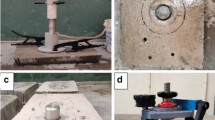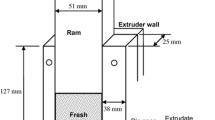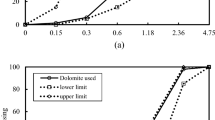This paper presents an experimental investigation on the static, microstructural and impact properties of concrete incorporating tire rubbers. Fine tire rubber (FR) and coarse tire rubber (CR) were used to replace fine and coarse aggregates, respectively, by 10 and 20% by volume. The single and combined effects of tire rubbers on the unit weight, mechanical properties (compressive strength, split tensile strength, flexural strength, and flexural toughness properties) and impact resistance of concrete were evaluated. Drop-weight test using concrete beams was conducted to evaluate the impact behavior of concrete. The microstructure of concrete was also investigated using SEM analysis. The results showed that incorporation of FR and CR reduced the unit weight, compressive strength, and flexural strength of concrete. Lower content of tire rubbers increased the split tensile strength of concrete, however higher content of tire rubbers resulted in its reduction. On the other hand, tire rubbers were found to remarkably enhance the energy absorption capacity, fracture energy and impact strength of concrete. SEM observations revealed that rubberized concretes had more porosity and weaker interfacial transition zone than normal concrete. In general, when FR and CR were used together, they showed an average static and impact performance compared to their single use.














Similar content being viewed by others
References
S. M. S. Kazmi, M. J. Munir, and Y.-F. Wu, “Application of waste tire rubber and recycled aggregates in concrete products: A new compression casting approach,” Resour Conserv Recycl, 167, 105353 (2021). https://doi.org/10.1016/j.resconrec.2020.105353
M. S. Döndüren and M. G. Al-Hagri, “A review of the effect and optimization of use of nano-TiO2 in cementitious composites,” Res Eng Struct Mater, 8, No. 2, 283–305 (2022). https://doi.org/10.17515/resm2022.348st1005
Q. S. Banyhussan, G. Yıldırım, Ö. Anıl, et al.,, “Impact resistance of deflection‐hardening fiber reinforced concretes with different mixture parameters,” Struct Concr, 20, No. 3, 1036–1050 (2019). https://doi.org/10.1002/suco.201800233
Ö. Anıl, C. Durucan, R. T. Erdem, and M. A. Yorgancilar, “Experimental and numerical investigation of reinforced concrete beams with variable material properties under impact loading,” Constr Build Mater, 125, 94–104 (2016). https://doi.org/10.1016/j.conbuildmat.2016.08.028
R. J. Gravina, and T. Xie, “Toward the development of sustainable concrete with Crumb Rubber: Design-oriented Models, Life-Cycle-Assessment and a site application,” Constr Build Mater, 315, 125565 (2022). https://doi.org/10.1016/j.conbuildmat.2021.125565
I. Zafar, K. Rashid, S. Tariq, et al., “Integrating technical-environmental-economical perspectives for optimizing rubber content in concrete by multi-criteria analysis,” Constr Build Mater, 319, 125820 (2022). https://doi.org/10.1016/j.conbuildmat.2021.125820
R. Zhang, H. Wang, J. Ji, et al., “Influences of different modification methods on surface activation of waste tire rubber powder applied in cement-based materials,” Constr Build Mater, 314, 125191 (2022). https://doi.org/10.1016/j.conbuildmat.2021.125191
H. Wang, Y. Wu, and B. Cheng, “Mechanical properties of alkali-activated concrete containing crumb rubber particles,” Case Stud Constr Mater, 16, e00803 (2022). https://doi.org/10.1016/j.cscm.2021.e00803
M. Jalal and H. Jalal, “Behavior assessment, regression analysis and support vector machine (SVM) modeling of waste tire rubberized concrete,” J Clean Prod, 273, 122960 (2020). https://doi.org/10.1016/j.jclepro.2020.122960
B. S. Thomas and R. Chandra Gupta, “Properties of high strength concrete containing scrap tire rubber,” J Clean Prod, 113, 86–92 (2016). https://doi.org/10.1016/j.jclepro.2015.11.019
L.-Y. Feng, A.-J. Chen, and H.-D. Liu, “Effect of waste tire rubber particles on concrete abrasion resistance under high-speed water flow,” Int J Concr Struct Mater, 15, No. 1, 37 (2021). https://doi.org/10.1186/s40069-021-00475-8
S. Dezhampanah, I. Nikbin, S. Charkhtab, et al., “Environmental performance and durability of concrete incorporating waste tire rubber and steel fiber subjected to acid attack,” J Clean Prod, 268, 122216 (2020). https://doi.org/10.1016/j.jclepro.2020.122216
C. Chen, X. Chen, and J. Zhang, “Experimental study on flexural fatigue behavior of self-compacting concrete with waste tire rubber,” Mech Adv Mater Struct, 28, No. 16, 1691–1702 (2021). https://doi.org/10.1080/15376494.2019.1701152
R. Alwi Assaggaf, S. Uthman Al-Dulaijan, M. Maslehuddin, et al., “Effect of different treatments of crumb rubber on the durability characteristics of rubberized concrete,” Constr Build Mater, 318, 126030 (2022). https://doi.org/10.1016/j.conbuildmat.2021.126030
R. Kumar, and N. Dev, “Mechanical and microstructural properties of rubberized concrete after surface modification of waste tire rubber crumb,” Arab J Sci Eng, 47, 4571–4587 (2022). https://doi.org/10.1007/s13369-021-06154-w
A. Habib, U. Yildirim, and O. Eren, “Mechanical and dynamic properties of high strength concrete with well graded coarse and fine tire rubber,” Constr Build Mater, 246, 118502 (2020). https://doi.org/10.1016/j.conbuildmat.2020.118502
A. A. Kadhim and H. M. K. Al-Mutairee, “An experimental study on behavior of sustainable rubberized concrete mixes,” Civ Eng J, 6, No. 7, 1273–1285 (2020). https://doi.org/10.28991/cej-2020-03091547
G. Martínez-Barrera, J. J. del Coz-Díaz, F. P. Álvarez-Rabanal, et al., “Waste tire rubber particles modified by gamma radiation and their use as modifiers of concrete,” Case Stud Constr Mater, 12, e00321 (2020). https://doi.org/10.1016/j.cscm.2019.e00321
A. Ali Emadi and A. Modarres, “Impact of crumb rubber particles on the fracture parameters of concrete through WFM, SEM and BEM,” Constr Build Mater, 305, 124693 (2021). https://doi.org/10.1016/j.conbuildmat.2021.124693
M. Medine, H. Trouzine, J. B. de Aguiar, and H. Djadouni, “Life cycle assessment of concrete incorporating scrap tire rubber: comparative study,” Rev Nat Technol, 12, No. 2, 1–11 (2020).
T. Gupta, R. K. Sharma, and S. Chaudhary, “Impact resistance of concrete containing waste rubber fiber and silica fume,” Int J Impact Eng, 83, 76–87 (2015). https://doi.org/10.1016/j.ijimpeng.2015.05.002
A. O. Atahan and A. Ö. Yücel, “Crumb rubber in concrete: static and dynamic evaluation,” Constr Build Mater, 36, 617–622 (2012). https://doi.org/10.1016/j.conbuildmat.2012.04.068
W. Feng, F. Liu, F. Yang, et al., “Experimental study on the effect of strain rates on the dynamic flexural properties of rubber concrete,” Constr Build Mater, 224, 408–419 (2019). https://doi.org/10.1016/j.conbuildmat.2019.07.084
W. Feng, F. Liu, F. Yang, et al., “Experimental study on dynamic split tensile properties of rubber concrete,” Constr Build Mater, 165, 675–687 (2018). https://doi.org/10.1016/j.conbuildmat.2018.01.073
P. Manoharan, P. T. Ravichandran, R. Annadurai, and P. R. Kannan Rajkumar, “Studies on properties of concrete using crumb rubber as fine aggregate,” in: Int. Comput. Intell. Conf. Appl. Proc. ICICA 2018, 2019, pp. 197–203. https://doi.org/10.1007/978-981-13-2182-5_20
M. C. Bignozzi and F. Sandrolini, “Tyre rubber waste recycling in self-compacting concrete,” Cem Concr Res, 36, No. 4, 735–739 (2006). https://doi.org/10.1016/j.cemconres.2005.12.011
TS EN 197-1, Cement – Part 1: Composition, Specifications and Conformity Criteria for Common Cements, [in Turkish], Ankara (2012).
TS 706 EN 12620, Concrete Aggregates [in Turkish], Ankara (2009).
TS EN 933-1, Tests for Geometrical Properties of Aggregates – Part 1: Determination of Particle Size Distribution – Sieving Method [in Turkish], Ankara (2012).
TS EN 1097-6, Tests for Mechanical and Physical Properties of Aggregates – Part 6: Determination of Particle Density and Water Absorption [in Turkish], Ankara (2013).
TS EN 1097-3, Tests for Mechanical and Physical Properties of Aggregates – Part 3: Determination of Loose Bulk Density and Voids [in Turkish], Ankara (1999).
TS EN 934-2, Admixtures for Concrete, Mortar and Grout – Part 2: Concrete Admixtures – Definitions, Requirements, Conformity, Marking and Labelling [in Turkish], Ankara (2011).
M. Jalal, A. A. Ramezanianpour, and M. K. Pool, “Split tensile strength of binary blended self compacting concrete containing low volume fly ash and TiO2 nanoparticles,” Compos Part B-Eng, 55, 324–337 (2013). https://doi.org/10.1016/j.compositesb.2013.05.050
M. Benaicha, A. Hafidi Alaoui, O. Jalbaud, and Y. Burtschell, “Dosage effect of superplasticizer on self-compacting concrete: correlation between rheology and strength,” J Mater Res Technol, 8, No. 2, 2063–2069 (2019). https://doi.org/10.1016/j.jmrt.2019.01.015
M. Khan and M. Ali, “Effect of super plasticizer on the properties of medium strength concrete prepared with coconut fiber,” Constr Build Mater, 182, 703–715 (2018). https://doi.org/10.1016/j.conbuildmat.2018.06.150
TS EN 12390-7, Testing Hardened Concrete – Part 7: Density of Hardened Concrete [in Turkish], Ankara, (2019).
TS EN 12390-3, Testing Hardened Concrete – Part 3: Compressive Strength of Test Specimens [in Turkish], Ankara (2019).
TS EN 12390-6, Testing Hardened Concrete – Part 6: Tensile Splitting Strength fo Test Specimens [in Turkish], Ankara (2010).
TS EN 12390-5, Testing Hardened Concrete – Part 5: Flexural Strength of Test Specimens [in Turkish], Ankara (2019).
L. A. Pereira de Oliveira and J. P. Castro-Gomes, “Physical and mechanical behaviour of recycled PET fibre reinforced mortar,” Constr Build Mater, 25, No. 4, 1712–1717 (2011). https://doi.org/10.1016/j.conbuildmat.2010.11.044
M. Mousavimehr and M. Nematzadeh, “Post-heating flexural behavior and durability of hybrid PET–Rubber aggregate concrete,” Constr Build Mater, 265, 120359 (2020). https://doi.org/10.1016/j.conbuildmat.2020.120359
A. S. Eisa, M. T. Elshazli, and M. T. Nawar, “Experimental investigation on the effect of using crumb rubber and steel fibers on the structural behavior of reinforced concrete beams,” Constr Build Mater, 252, 119078 (2020). https://doi.org/10.1016/j.conbuildmat.2020.119078
ASTM C1609, Standard Test Method for Flexural Performance of Fiber-Reinforced Concrete (Using Beam with Third-Point Loading), ASTM International, West Conshohocken (2010).
E. A. H. Alwesabi, B. H. A. Bakar, I. M. H. Alshaikh, et al., “Experimental investigation on fracture characteristics of plain and rubberized concrete containing hybrid steel-polypropylene fiber,” Structures, 33, 4421–4432 (2021). https://doi.org/10.1016/j.istruc.2021.07.011
RILEM 50-FMC Draft Recommendation, “Determination of the fracture energy of mortar and concrete by means of three-point tests on notched beams,” Mater Struct, 18, 287–290 (1985). https://doi.org/10.1007/BF02472918
A. T. Noaman, B. H. Abu Bakar, H. M. Akil, and A. H. Alani, “Fracture characteristics of plain and steel fibre reinforced rubberized concrete,” Constr Build Mater, 152, 414–423 (2017). https://doi.org/10.1016/j.conbuildmat.2017.06.127
S. F. Lee and S. Jacobsen, “Study of interfacial microstructure, fracture energy, compressive energy and debonding load of steel fiber-reinforced mortar,” Mater Struct, 44, No. 8, 1451–1465 (2011). https://doi.org/10.1617/s11527-011-9710-4
ASTM C1018, Standard Test Method for Flexural Toughness and First-Crack Strength of Fiber-Reinforced Concrete (Using Beam with Third-Point Loading), ASTM International, West Conshohocken (1997).
F. Çivici, “Flexural toughness of steel fiber reinforced concrete,” Pamukkale Üniversitesi Mühendislik Bilim. Derg., 12, No. 2, 183–188 (2006).
A. Yavaş, T. Birol, K. Türker, et al., “Improvement on flexural performance of UHPFRC with hybrid steel fiber,” Teknik Dergi, 30, No. 6, 10379–10397 (2020). https://doi.org/10.18400/tekderg.485565
M. A. Aiello and F. Leuzzi, “Waste tyre rubberized concrete: properties at fresh and hardened state,” Waste Manag, 30, Nos. 8–9, 1696–1704 (2010). https://doi.org/10.1016/j.wasman.2010.02.005
M. M. Reda Taha, A. S. El-Dieb, M. A. Abd El-Wahab, and M. E. Abdel-Hameed, “Mechanical, fracture, and microstructural investigations of rubber concrete,” J Mater Civ Eng, 20, No. 10, 640–649 (2008). https://doi.org/10.1061/(ASCE)0899-1561(2008)20:10(640)
A. S. Eisa, A. Gab Allah, R. S. Mahmoud, and A. Ibrahim, “Flexural and shear behavior of rubberized high strength reinforced concrete beams strengthened with CFRP,” Int J Struct Civ Eng Res, 10, No. 3, 98–105 (2021).
S. Raffoul, R. Garcia, K. Pilakoutas, et al., “Optimisation of rubberised concrete with high rubber content: an experimental investigation,” Constr Build Mater, 124, 391–404 (2016). https://doi.org/10.1016/j.conbuildmat.2016.07.054
N. N. Gerges, C. A. Issa, and S. A. Fawaz, “Rubber concrete: mechanical and dynamical properties,” Case Stud Constr Mater, 9, e00184 (2018). https://doi.org/10.1016/j.cscm.2018.e00184
M. M. Al-Tayeb, B. H. A. Bakar, H. Ismail, and H. M. Akil, “Impact resistance of concrete with partial replacements of sand and cement by waste rubber,” Polym Plast Technol Eng, 51, No. 12, 1230–1236 (2012). https://doi.org/10.1080/03602559.2012.696767
T. Rahmani, B. Kiani, M. Shekarchi, and A. Safari, “Statistical and experimental analysis on the behavior of fiber reinforced concretes subjected to drop weight test,” Constr Build Mater, 37, 360–369 (2012). https://doi.org/10.1016/j.conbuildmat.2012.07.068
M. M. Al-Tayeb, B. H. Abu Bakar, H. M. Akil, and H. Ismail, “Performance of rubberized and hybrid rubberized concrete structures under static and impact load conditions,” Exp Mech, 53, No. 3, 377–384 (2013). https://doi.org/10.1007/s11340-012-9651-z
F. Hernández-Olivares, G. Barluenga, M. Bollati, and B. Witoszek, “Static and dynamic behaviour of recycled tyre rubber-filled concrete,” Cem Concr Res, 32, No. 10, 1587–1596 (2002). https://doi.org/10.1016/S0008-8846(02)00833-5
H. A. Toutanji, “The use of rubber tire particles in concrete to replace mineral aggregates,” Cem Concr Compos, 18, No. 2, 135–139 (1996). https://doi.org/10.1016/0958-9465(95)00010-0
Q.-H. Han, G. Yang, and J. Xu, “Experimental study on the relationship between acoustic emission energy and fracture energy of crumb rubber concrete,” Struct Control Heal Monit, 25, No. 10, e2240 (2018). https://doi.org/10.1002/stc.2240
A. Grinys, H. Sivilevičius, D. Pupeikis, and E. Ivanauskas, “Fracture of concrete containing crumb rubber,” J Civ Eng Manag, 19, No. 3, 447–455 (2013). https://doi.org/10.3846/13923730.2013.782335
S. Erdem, A. R. Dawson, and N. H. Thom, “Microstructure-linked strength properties and impact response of conventional and recycled concrete reinforced with steel and synthetic macro fibres,” Constr Build Mater, 25, No. 10, 4025–4036 (2011). https://doi.org/10.1016/j.conbuildmat.2011.04.037
M. Nili and V. Afroughsabet, “The effects of silica fume and polypropylene fibers on the impact resistance and mechanical properties of concrete,” Constr Build Mater, 24, No. 6, 927–933 (2010). https://doi.org/10.1016/j.conbuildmat.2009.11.025
J. J. Li, J. G. Niu, C. J. Wan, et al., “Investigation on mechanical properties and microstructure of high performance polypropylene fiber reinforced lightweight aggregate concrete,” Constr Build Mater, 118, 27–35 (2016). https://doi.org/10.1016/j.conbuildmat.2016.04.116
M. M. Al-Tayeb, B. H. Abu Bakar, H. Ismail, and H. M. Akil, “Effect of partial replacement of sand by recycled fine crumb rubber on the performance of hybrid rubberized-normal concrete under impact load: experiment and simulation,” J Clean Prod, 59, 284–289 (2013). https://doi.org/10.1016/j.jclepro.2013.04.026
D. Li, J. Xiao, Y. Zhuge, et al., “Experimental study on crumb rubberised concrete (CRC) and reinforced CRC slabs under static and impact loads,” Aust J Struct Eng, 21, No. 4, 294–306 (2020). https://doi.org/10.1080/13287982.2020.1809811
S. Demirhan, G. Yıldırım, Q. S. Banyhussan, et al., “Impact behaviour of nano-modified deflection-hardening fibre reinforced concretes,” Mag Concr Res, 72, No. 17, 865–887 (2020). https://doi.org/10.1680/jmacr.18.00541
W. Zhao and Q. Guo, “Experimental study on impact and post-impact behavior of steel-concrete composite panels,” Thin Wall Struct, 130, 405–413 (2018). https://doi.org/10.1016/j.tws.2018.06.012
V. D. Nguyena, O. Ríoa, and V. Sánchez-Gálvezb, “Performance of hybrid cement composite elements under drop-weight impact load,” Mater Construcción, 64, No. 314, e017 (2014).
D. Foti and F. Paparella, “Impact behavior of structural elements in concrete reinforced with PET grids,” Mech Res Commun, 57, 57–66 (2014). https://doi.org/10.1016/j.mechrescom.2014.02.007
D. A. Silva, A. M. Betioli, P. J. P. Gleize, et al., “Degradation of recycled PET fibers in Portland cement-based materials,” Cem Concr Res, 35, No. 9, 1741–1746 (2005). https://doi.org/10.1016/j.cemconres.2004.10.040
D. Werdine, G. A. Oliver, F. A. de Almeida, et al., “Analysis of the properties of the self-compacting concrete mixed with tire rubber waste based on design of experiments,” Structures, 33, 3461–3474 (2021). https://doi.org/10.1016/j.istruc.2021.06.076
A. Abdelmonem, M. S. El-Feky, E.-S. A. R. Nasr, and M. Kohail, “Performance of high strength concrete containing recycled rubber,” Constr Build Mater, 227, 116660 (2019). https://doi.org/10.1016/j.conbuildmat.2019.08.041
Acknowledgments
The authors gratefully acknowledge the funding from Scientific Research Projects (Bilimsel Araştırma Projeleri – BAP) via project no. 201104025 for this research.
Author information
Authors and Affiliations
Corresponding author
Additional information
Translated from Problemy Mitsnosti, No. 5, p. 128, September – October, 2023.
Rights and permissions
Springer Nature or its licensor (e.g. a society or other partner) holds exclusive rights to this article under a publishing agreement with the author(s) or other rightsholder(s); author self-archiving of the accepted manuscript version of this article is solely governed by the terms of such publishing agreement and applicable law.
About this article
Cite this article
Döndüren, M.S., Al-Hagri, M.G. Single and Combined Effect of Fine and Coarse Tire Rubbers on the Static, Microstructural, and Impact Properties of Concrete. Strength Mater 55, 1055–1078 (2023). https://doi.org/10.1007/s11223-023-00596-3
Received:
Published:
Issue Date:
DOI: https://doi.org/10.1007/s11223-023-00596-3




